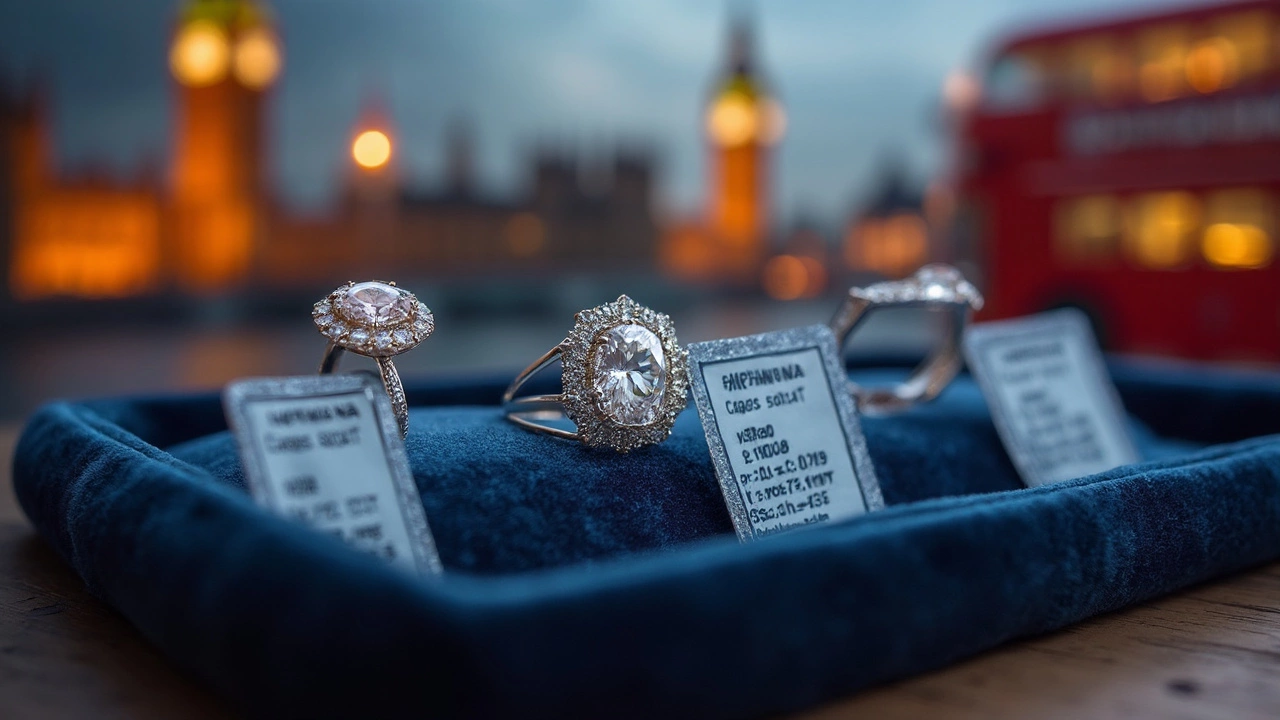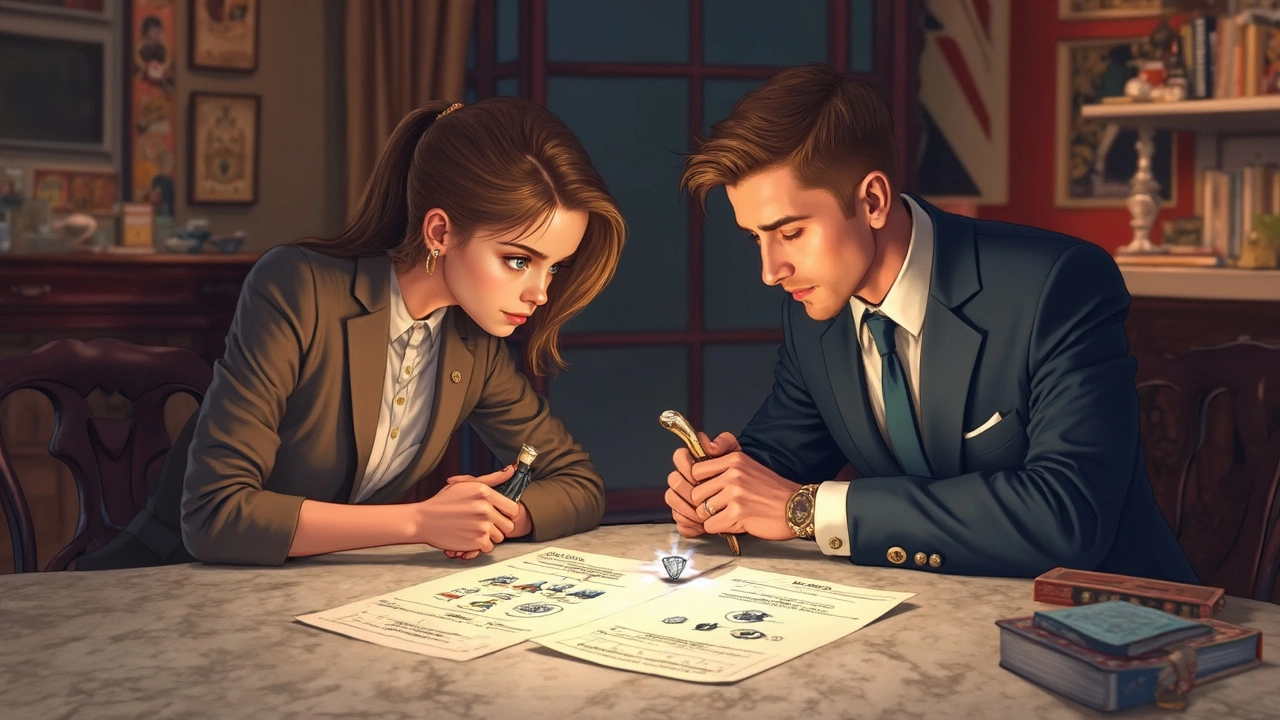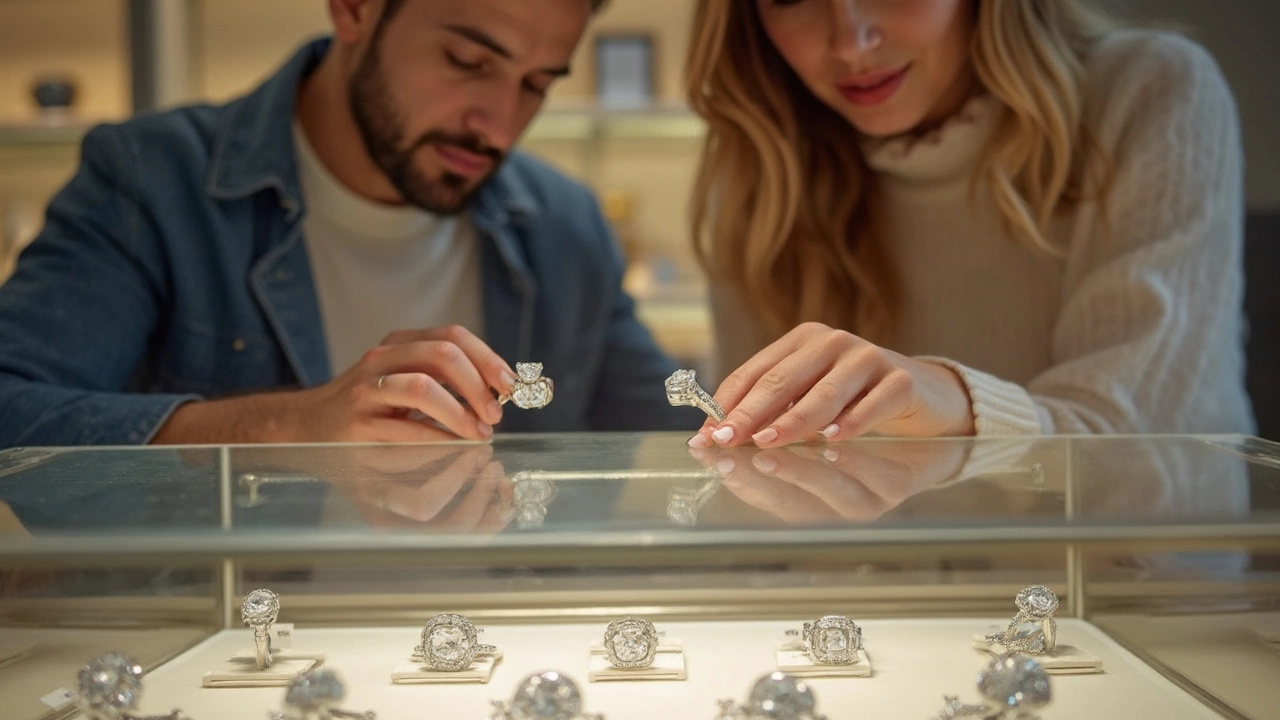Most people hear $10,000 and picture a ring so flashy you’d need sunglasses. But what does a $10,000 wedding ring actually look like in real life? Well, it’s not as dramatic as Instagram makes it seem, but you get something really impressive—if you know what you’re looking for.
When it comes to rings, bigger price tags usually mean either a larger center stone, better quality, a fancier design, or all three. But $10,000 isn’t just about size. Diamond quality, type of metal, and the designer's brand play a huge part. Some folks choose a smaller but super clear diamond, while others go for a bigger stone with more character.
You’ll want to know about diamond grading—the 4Cs: carat, cut, color, and clarity—since these have the biggest impact on what your ring will look like. For example, you might get a well-cut one-carat diamond or a slightly larger stone with a bit of color that still sparkles like crazy. And the setting—think gold versus platinum—also makes a difference, both in price and feel. $10,000 gives you plenty of wiggle room for personal style, but knowing where to spend (or save) is key if you want the best look for your budget.
- What Does $10,000 Actually Buy in a Ring?
- Diamond Size, Quality, and the 4Cs
- Gold, Platinum, and Setting Choices
- Real-Life Examples and Comparisons
- Smart Shopping Tips for Your Budget
What Does $10,000 Actually Buy in a Ring?
The truth? A $10,000 ring puts you in a sweet spot for quality, but it isn’t an automatic ticket to a gigantic rock. Most jewelers will tell you that this budget gets you what everyone wants—a balance of size, sparkle, and solid craftsmanship. But what does that actually mean?
For starters, if you’re focusing on diamonds, $10,000 usually covers a center diamond between 1.2 and 1.5 carats with pretty impressive clarity and color if you go with gold rather than platinum. The exact size depends on the other "specs" you choose: a flawless diamond will be smaller than one with tiny inclusions, simply because perfection costs way more per carat.
Here’s a quick comparison of what you can expect to get, depending on how you play with the grades and materials:
| Feature | Typical $10,000 Ring | Luxury Option (for same budget) |
|---|---|---|
| Diamond Carat | 1.2 - 1.5 ct | 1.6 - 2 ct (lower color/clarity) |
| Diamond Clarity | VS2 - SI1 (eye clean) | SI2 - I1 (flaws visible under magnification) |
| Diamond Color | G - H (near colorless) | J - K (slightly tinted) |
| Metal | 14k/18k gold | Platinum (smaller diamond) |
| Setting | Solitaire or halo | Designer/intricate (less money for diamond) |
If classic round diamonds aren’t your thing, you can make your money stretch even more by picking fancy shapes like oval, pear, or emerald cut. These cuts often look bigger because they’re spread out wider, so your 10000 dollar ring can give off “huge diamond” vibes without actually costing more per carat.
You could even go for a lab-grown diamond and get a larger or higher quality stone for the same price. Sometimes, lab stones go up to 2.5 carats on this budget, and most people can’t tell them apart from natural ones without a microscope.
Bottom line: for $10,000, you’re not getting a celebrity-level extravaganza, but you are getting a ring that turns heads and lasts for life. Just pick what matters most to you—size, sparkle, or brand name is usually the way to narrow it down.
Diamond Size, Quality, and the 4Cs
Let’s clear things up: size isn’t the only thing that decides the “wow” factor of a $10,000 ring. Diamond grading boils down to four main things—known as the 4Cs. They actually control how big, sparkly, and good-looking your diamond appears, and how much you end up paying for it.
Here’s what you’re looking at with the 4Cs:
- Carat (weight/size): With a $10,000 budget, a round brilliant diamond typically lands between 0.9 and 1.3 carats if you pick a good balance between the other Cs. A 1-carat round diamond is the most popular choice and sits right in the sweet spot for size vs. price. Fancy shapes, like ovals or pears, may actually look bigger than rounds at the same carat, so you might get more visual bang for your buck if you’re open to something other than round.
- Cut (sparkle): Diamonds that are well-cut look brighter, even if they aren’t the largest. Cut matters more to sparkle than size or clarity. For $10,000, you can often find round stones graded “Excellent” or “Very Good” for cut, which means your diamond is going to catch the light in all the right ways.
- Color (tint): The less color, the pricier it gets. For the price range, most buyers snap up diamonds graded from G to I (near-colorless), which still look white in most settings. If you want a yellow or rose gold band, you can even go a shade lower, since the band’s color makes the diamond look whiter.
- Clarity (flaws): Most flaws, or “inclusions,” are too tiny for human eyes to catch. For $10,000, look for clarity grades like VS1, VS2, or SI1. These have tiny imperfections that won’t show without a special magnifier.
Remember, when you’re shopping for a 10000 dollar ring, the trick is to find the sweet spot. If you sacrifice a little in color or clarity, you can boost size or cut and your ring will still catch plenty of attention. Don’t just max out one C—balance all four to get a ring that really pops in person.

Gold, Platinum, and Setting Choices
The part of the ring that holds the diamond (the setting) and the metal you pick for the band make a surprising difference in both price and look. The most common choices are yellow gold, white gold, rose gold, and platinum. Each one has its own vibe and price tag, so it pays to know the pros and cons before you commit.
Let’s break down the usual suspects:
- White gold is popular for its modern look and affordability. It usually costs less than platinum but needs to get re-plated over the years to keep that bright white shine.
- Yellow gold is the classic choice. It’s easier to resize than platinum and tends to stand out. 14k yellow gold (58% gold) is more durable for everyday wear than higher-karat gold, which is softer.
- Rose gold has a pinkish hue from the copper mixed in. It's been trending for a while now and, bonus, it usually costs about the same as yellow or white gold.
- Platinum is heavier and more durable than gold. Unlike white gold, it won’t lose its color, but it does scratch more easily (the scratches are more like dull spots rather than deep cuts). It’s noticeably more expensive—expect to pay roughly 40%-60% more for the same ring style in platinum than in gold.
Here’s an at-a-glance rundown of price differences for a standard solitaire wedding ring (one carat center diamond) in the US:
| Metal Type | Average Setting Cost (USD) - 2025 |
|---|---|
| 14k White Gold | $600 - $1,200 |
| 18k Yellow Gold | $800 - $1,400 |
| 14k Rose Gold | $600 - $1,200 |
| Platinum | $1,200 - $2,000 |
Want more for your money? If your budget is around $10,000, putting less into the metal (say, choosing 14k gold over platinum) lets you spend more on your actual diamond. That’s a smart move since the stone usually makes up 80-85% of what you see and pay for in a 10000 dollar ring.
Settings come in dozens of styles too—solitaire, halo, vintage, three-stone, and more. Halos (where smaller diamonds surround the main diamond) make the center stone look bigger for less, and three-stone settings let you balance quality and size across a unique design. With a $10,000 budget, you can usually afford some extra detail like hidden accents or engravings without tipping over your limit.
The best tip? Decide what matters most: longevity, look, or getting the flashiest diamond for your cash. Once you have a handle on the metals and design styles, you’ll get a ring that nails both style and value.
Real-Life Examples and Comparisons
So, what exactly do you get if you walk into a jeweler with $10,000 to spend on a wedding ring? The answer really depends on your choices, but let's break it down using real numbers and actual rings you can buy today.
At most major U.S. retailers, $10,000 usually gets you a diamond solitaire ring with a center stone between 1.2 and 1.5 carats, decent clarity (VS2–SI1), and good color (G–I). If you’re willing to go just under a carat—say, 0.90–1.00—you might get a stone that’s top-notch in every way (think D–F color, flawless to VS1 clarity, and an ideal cut) on a platinum band.
Some people ditch the solitaire trend and get a halo or pavé setting instead. This stretches your budget, making the center diamond look bigger thanks to the surrounding stones. Halo and vintage-inspired settings are smart moves if “show-stopping” is the goal.
Here's a quick comparison of what you might see online or in-store for about $10,000 (as of early 2025):
| Ring Style | Diamond Size | Diamond Quality (Color/Clarity) | Metal Type | Brand/Retailer |
|---|---|---|---|---|
| Solitaire | 1.2 ct | G, VS2 | Platinum | Blue Nile |
| Halo | 1.0 ct (center) | H, SI1 | 18k White Gold | James Allen |
| Three-Stone | 0.8 ct (center) + two 0.5 ct sides | F, VS2 | Yellow Gold | Tiffany & Co. (pre-owned) |
| Pavé | 1.1 ct | I, VS1 | 14k Rose Gold | KAY Jewelers |
If you’re open to lab-grown diamonds, the numbers change a lot. A $10,000 lab-grown diamond ring can easily get you a 2.5 or even 3-carat stone with top-level cut, color, and clarity. That’s more than double the size for the same cash outlay.
Comparing a $10,000 ring to typical engagement rings in the U.S., it’s clear you’re shopping at the top end. The average spend on a ring is closer to $6,000, and a lot of those are around 1 carat—with lower color or clarity. With $10,000, your ring will stand out for both size and sparkle.
Quick reality check: Brand name plays a huge role. If you’re going for a designer label like Tiffany or Cartier, the same specs cost more because of the brand cachet. Pre-owned rings from luxury houses can be a hack to get higher quality for less.
Looking for a 10000 dollar ring? Keep design, source, and setting in mind for the best mix of wow and value. Decide if you want to go big on size or max out on clarity and color, and don’t be afraid to look at different retailers or even estate pieces for better deals.

Smart Shopping Tips for Your Budget
If you're about to spend $10,000 on a wedding ring, it pays to be smart about every choice. It's not just about the bling—it's about making every dollar stretch so you walk away happy, not second-guessing.
- Choose Which “C” Matters Most: The 4Cs (carat, cut, color, clarity) aren't all equal in bang for your buck. A killer cut will make even a slightly smaller diamond look way brighter. Prioritize cut first, then play around with color and clarity to see where you can save a little cash without losing that wow factor.
- Go Just Below Popular Carat Marks: Diamonds priced just under whole numbers like 1.0 or 1.5 carats can look almost the same but cost hundreds or even thousands less. A 0.95 carat stone can look nearly identical to a 1-carat one once it's set.
- Shop Around—But Don’t Obsess Over the Brand: Big names can bump up prices for the same specs. Local jewelers and online retailers sometimes offer better value, with just as much sparkle.
- Consider Lab-Grown Diamonds: These aren’t fakes—they’re real diamonds grown in a lab and can cost 40-60% less than mined stones for the same size and quality.
- Don’t Sleep on the Setting: White gold, yellow gold, or platinum—each metal changes the price. If you want a chunkier, more dramatic band, gold will save you more than platinum.
- Ask for Certifications: Always make sure your diamond is certified by a legit authority like GIA or AGS. No certificate? That's a red flag for value and resale.
To give you a quick sense of how your choices shift the 10000 dollar ring market, check out this comparison table:
| Option | Carat Size | Diamond Type | Band Metal | Approx. Price ($) |
|---|---|---|---|---|
| Traditional mined diamond | 1.0 carat | Natural | Platinum | ~$10,000 |
| Lab-grown diamond | 1.5 carats | Lab-grown | 14K gold | ~$10,000 |
| Designer setting, smaller stone | 0.8 carat | Natural | 18K gold | ~$10,000 |
| Classic solitaire | 0.95 carat | Natural | White gold | ~$9,700 |
This table shows just how much flexibility you really have. You can go bigger by picking lab-grown, snag something truly unique with a designer band, or stick with the classics and max out carat size. Just don’t get tunnel vision on one feature—mix and match for the look (and price) that fits you best.

